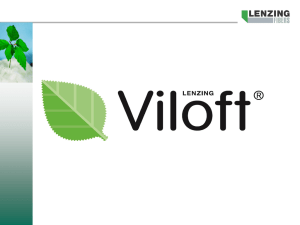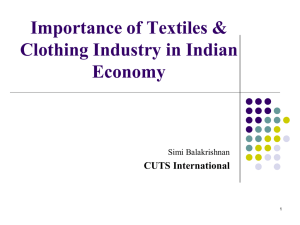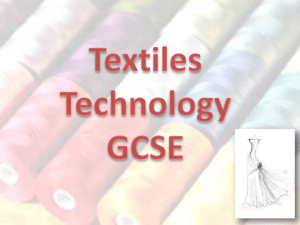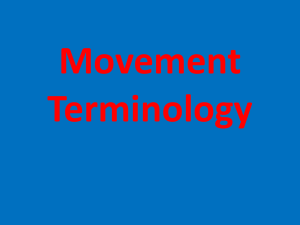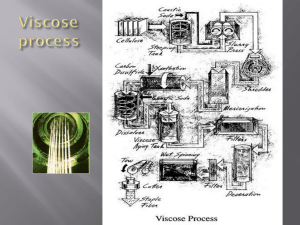Raw materials for Technical Textiles, Birla by Manohar Samuel.
advertisement
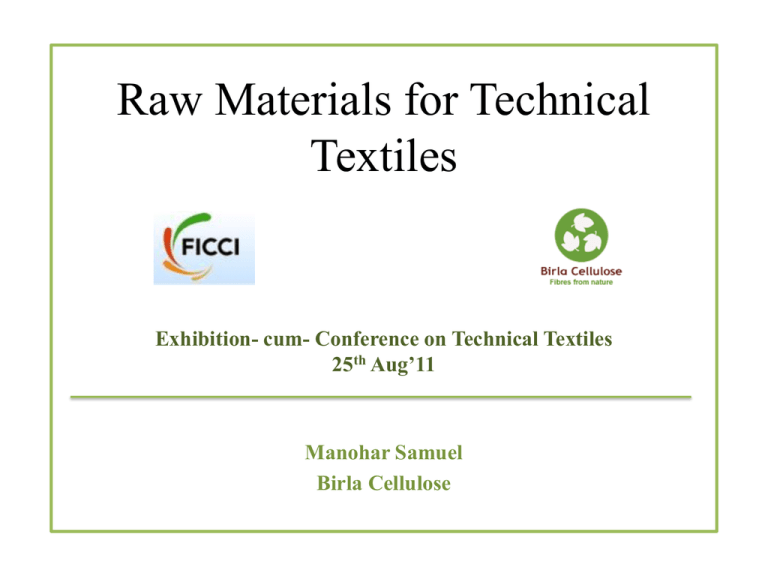
Raw Materials for Technical Textiles Exhibition- cum- Conference on Technical Textiles 25th Aug’11 Manohar Samuel Birla Cellulose Presentation Covers……. • Fibres and Functional value in technical textiles • Business Growth recommendation for technical textiles Global Fiber Production Scenario All Fibres Mn T – In Million Tons 80 Million T Apparel/Textiles: Million T Technical Textiles: Million T Manmade Natural 54 Mn T 26 Mn T Wool Silk Cotton 1 Mn T 0.15 Mn T 24 Mn T Linen 0.52 Mn T Polyester Nylon Acrylic Olefin Others 37 Mn T 4 Mn T 1.98 Mn T 6 Mn T 1 Mn T Synthetics Cellulosic # 50 Mn T 4.28Mn T Tow (Acetate/ Viscose) 0.7 Mn T Staple (Viscose) 3.2 Mn T Filament (Acetate, Viscose, Cupro) 0.38 Mn T Jute –extra Source : Fibre Organon Based on Average Production as on 2010 World Fibre Basket in last five years 2010 (KTons) Share 23% 17159 21.4% 2% 24574 36% 33036 41.3% 6% Cotton 24487 36% 24460 30.5% 0% VSF 2076 3% 3246 4.1% Others 1838 3% 2182 Total 68431 100% 80083 Fibre Synthetics Staple Synthetics Filament 2005 (KTons) Share 15456 % CAGR % Capacity K tons Share % 17858 21.1% 35158 41.5% 27400 26000 30.7% 9.4% 4193 3759 4.4% 2.7% 3% 553 2000 2.4% 100.0% 3.2% 98416 84775 100% 22322 43948 • Dominance of Synthetic filament yarns • Cotton is flat but highly sought after due to its properties • Consistent growth in VSF with highest CAGR% Source:- Fibre Organon Jun-11 2012 K tons (Projected) Technical Textiles – Importance of Fibre What is Technical Textile? Textile products manufactured primarily for their technical and performance properties How do we get the Functional Performance for the End User? Differentiation at Fibre stage Yarn Stage Fabric Stage Wet Processing Stage Technology at Fibre, yarn, Fabric and End Conversion stage Raw Materials for Technical Textiles 1. Regular/Generic fibers • • • Natural fibers: Cotton, silk, wool, jute, hamp, ramie, flax Regenerated fibers: Viscose, Lyocell. Synthetic fibers: Nylon, PET, PP, Acrylic. 2. Specialty variants of regular/generic fibers • • • • Flame retardant Super absorbent Antimicro bacterial Ultra fine fibers. etc. 3. High tech/high performance fibers: • • High chemical- and combustion-resistant organic fibres: Nomex, Kevlar High performance inorganic fibres: Glass, Asbestos, Carbon Worldwide Fiber composition in Technical Textiles • World over, PSF/PFY and PP based products have maximum application in Technical textile, comprising over 50% of the share, the applications are across product categories and usage • Viscose and other cellulosic fibres has 6% share Fiber composition in Technical Textiles in India • In India the fibre composition in Technical Textile is quite contrasting to the world as natural fibres have 50% share. • Viscose, Cellulosic and Regenerated fibre comprise of 6.6% share which is comparable to the share of these fibres in technical textiles across the world • Glass fibre for Technical textile in India is just 2.1% where as worldwide it has a 15% share World Technical Textiles Consumption, 2010 $ 127 bn. 23,774,000 tons Sportech although is 6% of the Volume, in Value terms it contributes 15%, Mobiltech is 14% in volume but 24% in value terms in 2010 Packtech is 15% in Volume but contributes 5% in Value terms, similarly hometech is 12% in volume terms but contributes 7% in volume terms Specialty Variants of Viscose, Polyester and other fibres Viscose Basic Characteristics Specialty Variant Polyester Basic Characteristic Other fibres Specialty Variant Fibre Additional Characteristic Very good softness Viscose for nonwovens High melting point, high heat and chemical resistance High Tenacity PET Superabsorbent fibre (acrylic) High absorbency Excellent absorbency Viscose with trilobal cross-section Very low moisture absorbency trilobal crosssection High Density Polyethylene (HDPE) High tensile strength Added strength and moderate abrasion resistance Temperature regulating Viscose (Outlast ) High strength, Good abrasion resistance,, Good resiliency Hollow fiber High Modulus PE (HMPE) Higher modulus Relatively poor strength wet Short cut PET/Viscose Inert, biocompatible & flexible Flame retardant High Tenacity Nylon High tenacity and low shrinkage Low resiliency Anti-microbial, Anti-bacterial viscose fibers. Anti-microbial, Anti-fungal, Anti-bacterial PET fibers. High Tenacity PP High strength and stability Natural and pure Fire Retardant (FR) Viscose/PET Cationic dyeable Anti bacterial Acrylic Prevents & limits the growth of bacteria, fungi and microbes. High-tech fibre Fiber Characteristics Applications Key players Meta Aramid (Nomex) Heat Resistance, high strength and high impact absorbing capacity Fire retardant apparel, bullet proof jackets, helmets, gloves etc. Dupont (USA), Teijin Twaron (Japan), SRO Group (China), Yantai Spandex (China), Kermel (France) Para Aramid (Kevlar) High strength to weight ratio, Excellent thermal & chemical stability Fire retardant apparel, bullet proof jackets, helmets, gloves etc. Dupont (USA), Teijin Twaron (Japan), Yantai Spandex (China) Carbon Low weight and high strength Air craft body, wind mill wings, racing cars. Toray Industries (Japan), Toho Tenax (Japan), Mitsubishi Rayon (Japan), Zoltek (USA), Hexcelcorp (USA), SGL Carbon AG (Germany) , Kemrock (India) Polyphenyle ne sulfide Fibres (PPS) Highly resistance to heat, acid and alkaline Electrical products, liquid filters, dryer canvas. Armoco Fabrics & Fibres Co (USA), Toyobo (Japan), Toray Industries (Japan), etc Glass fiber Thermal insulation properties with high strength and low elongation. Automotive bodies, hockey sticks, boats, surfboard etc. Owens-Corning Fibreglas, Nicofiber (USA), Fibreglass (Canada), Asahi Fibre Glass Co (Japan), Chemitex-Anilana (Poland), Owens Corning , Goa glass, Twiga (india) High-tech fibre Fiber Characteristics Applications Key players Polytetrafluor oethylene (PTFE) Excellent dielectric properties, high melting point. Nonstick coating of pans, laboratory containers, magnetic stirrer. DuPont (USA), Newton Filaments, Inc (USA), Albany Internation Inc. (USA), Toyobo (Japan) Phenolic fiber High strength Automotive and electrical components. Phenco (USA), The Vermont Organic Fiber Company (USA) Conductive fiber Electric conductive Military garments, intelligent garments. Shakespeare Conductive Fibres LLC and Bekaert , Bakaert India (India) PBI (Polybenzimid azole) High strength and does not burn or melt. Automotive parts, aircraft parts, insulation shield etc. Celanese Acetate Alginate fiber Highly absorbent Wound dressing, textile printing etc. Speciality Fibres and Materials Ltd (UK), FMC Biopolymer (USA), Degussa Texturant Systems (Germany), Danisco Cultor (Denmark), Kimica Corporation (Japan), China Seaweed Industrial Association (China) PBO fiberZylon Highest strength among fibers. Protective clothing and equipments. Toyobo Co. Ltd. (Japan) Segment wise consumption of different fibres Cotton Jute Viscose Agrotech Meditech Mobiltech PET Nylon PP HDPE LDPE/ LLDPE Packtech Sporttech Buildtech Clothtech Hometech Protech Oekotech Carbon Glass Geotech Inditech Aramid Tech Textile – Growth Role of Fibre Manufacturers Technical Textiles – Indian Business Growth Focus India as Global Manufacturing Hub India as Consuming Hub owing to the large population The Key Challenge has been always whether Market comes first or the product The Answer is both come together…… Business Development – Components & Focus Fibre Innovation first time for India Fibre Innovation first time in the world Product Development Fibre Innovation Application Development for new Product New Markets Entry Market Development Market Innovation Application Development Specific to Particular markets Business Development Role of Centre of Excellence in Tech Textiles 1. Product Development Centre of Excellence - Technical project and research - Proactive Products -Small Sampling 2. Application Development -Tests & Standards Recipes - Global vendor Base 3. Market Development -USP formulation -Tech Transfer Service Review and Recommendations for Growth of Tech Textile Sector Recommendations : Market Mapping #1 • A global understanding o f the Tech Textile sector in size • Ministry of Textiles can extend the base line survey to Global context • Market potential from current to the next ten years mapped for need gap analysis a.Technology and equipment gap – bring in partners b.Specialty fibre gap – Aramid, Glass fibre etc. R&D and collaborations c.Capital equipment Gap - collaboration from abroad. Recommendations : Product Understanding- Role of COE’s #2 • To Buy out relevant International samples and decode • Create facility for Prototype development exactly matching • Build a studio for their specialization with International samples • Commercials made for each potential product with Industry • Tabulate different comparative standards • Formulate Indian standards for application based Recommendations : Product Understanding- Role of IITA #3 • ITTA should support standard formulation t a.Buyer’s standards not mentioned in Global standards b.Support COE’s for fixing Indian standards with BIS • ITTA should support technical projects with COE’s a.Practical projects which help to understand Indian conditions b.Commercial information on worthwhile projects • ITTA should make a lifetime benefit for large applications - shared with respective user industry ministry along with Textile Commissioner’s Office Recommendations : Role of Gov. for Legislation #4 • Gov. of India’s legislation for the safety, cost and welfare of the common man in the following areas wud help. a.Only BIS and pharmacopeia consistent meditech products b.Flame retardant fabrics in public places and railways, buses c.Geo tech in all express ways, highways, dams and rail tracks d.Protech for firemen, mining, defense sectors • Textile Ministry support with the other Ministry’s a.Health Ministry for meditech products and DGCA b.Railways Ministry for Geotech c.Education Ministry for including Tech Tex in syllabus of *Meditech for MBBS *Geotech for Civil Engineers *Agritech for agricultural engineering *ITI courses for operations of tech textiles Recommendations : Role of Gov. for Fiscal & Non Fiscal Correction #5 • Excise duty to be at least in line with regular textiles for nonwoven tech textiles. • Duty drawback and DEPB for nonwoven and converted products do not find a mention and needs to be notified • Specific HS codes is proposed for specialty fibres • All standards for Non-implantables should have Woven & Nonwoven both as product option; and should thus find a place in govt. tenders Recommendations : Role of Indian Textile Industry for Technical Textiles #7 • Leaders in Industry to work with Gov to set up specific Tech Textile parks similar to Apparel parks. • Technical Textiles should be promoted by all stakeholders a.Conferences with actual cost benefit and user industry participation for each sector b.International Technical Textile Exhibitions c.Specific websites for technical textiles in Gov. and Industry Association forums Thank You for your attention


